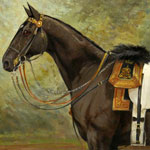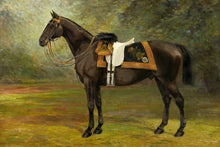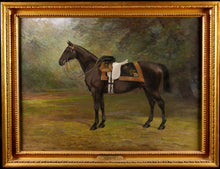The 1st Life Guards - An Officer’s Charger, 1899
SOLD
Tax included.
Adding product to your cart
Overall: 55cm (21.75in) x 70cm (27.5in)
Oil on canvas. An officer’s charger of the 1st Life Guards the equipped with the full dress shabraque of blue cloth with the fore and hind quarters pointed; three stripes of gold lace and two of scarlet cloth all round. On each hind corner, a crown, scrolls bearing the Battle Honours ‘Dettingen’, ‘Peninsula’, ‘Waterloo’, ‘Egypt, 1882’ and ‘Tel-el-Kebir,’ and reversed LG cypher embroidered in gold with a Garter star below. Holster covers of blue cloth, laced to match the shabracque, with the crown and regimental cypher with one above embroidered in gold: black bearskin caps. Doeskin seat and white web surcingle. Signed and dated August 1899 lower left. Contained in a period gilt wood frame.
As household troops the 1st Life Guards were exempt from the directives that did away with costly shrabraques for the Dragoon Guards and Line Cavalry in the 1890s. Moreover, the 1st L.G. shabraque had its origins in the 1830s and the holster covers harked back even further to the late eighteenth century. In 1922, when the 1st and 2nd Life Guards amalgamated, the new regiment adopted the shabraque of the 2nd Life Guards which is the one carried today, albeit with many more battle honours.
William Josiah Redworth (1873-1945) painted a number of chargers for officers of the Life Guards in late 1899 and 1900. These included a pair for the Hon A.F. Stanley who later commanded the regiment, and Surgeon Cross who served with the regiment in South Africa. Redworth trained at Chelsea Art School and showed in the major London exhibition venues including the Royal Academy and Royal Institution. He also exhibited in Scotland at the Royal Scottish Academy.
Use left/right arrows to navigate the slideshow or swipe left/right if using a mobile device






